The Impact of Circadian Rhythms on Resistance Training Performance SPS4036
- Subject Code :
SPS4036
Introduction
Resistance training or weight training has been known to offer multiple advantages, including increased strength and muscle bulk, better brain health, and general well-being. Although the history of RT dates back to the late 19th century, the emphasis has been placed mostly on manipulating variables such as frequency, intensity, type, and duration of exercise (Behm et al., 2023).
It has been postulated that the timing of exercise can impact performance, but conclusive prescription on when is still a stranger. Researchers have postulated that perhaps RT might be better in the later part of the day because of changes in the physiological predispositions that occur during the day. On the other hand, there were no well-defined policies concerning the right time to perform radiation therapy. This difference clearly shows a research gap and, therefore, calls for more studies about whether exercise timing can influence training outcomes (Edwards et al., 2024).
It was also found that it may be important to know the optimally effective time of day for RT, as it may benefit both amateur and professional athletes and individuals seeking to improve their overall fitness levels. One intriguing aspect might be the fact that the human body is home to circadian rhythms, which are physiological processes that follow a certain cycle. For instance, muscle strength and endurance may vary in response to these rhythms, potentially influencing performance. Since performance and recovery are strategic for the enhancement of the effects of RT, understanding the effects of exercise timing is important. Another well-known fact about involving oneself in any form of resistance training is the necessity of warming up before the activity. Failure to warm up can be detrimental, as it can lead to lower performance, muscle rigidity, and a higher risk of injury (APA PsycNet, n.d.).
Therefore, this study will ensure that the warm-up done regularly excludes the impacts of warm-up workouts on exercise timing. Moreover, proper nutrition, including the required caloric intake, is crucial to increase the effectiveness of training. Evidence has shown that when the right nutrients are ingested pre-, during, and post-exercise, training gains and muscle recovery can be optimized. By controlling pre-and intra-workout nutrition in this study, the goal is to reduce the variability of RTs effectiveness due to the time of day (Holdbrook et al., 2024).
Material & Methods
Methodology
The time of day that low-intensity training (RT) is performed is best determined by balancing the duration of the workout, warm-up, and nutrition. The approach involves a comprehensive assessment of these conditions using experimental methods to produce valid and reliable results.
Participants
Random adults from Premier Fitness Gymnasium in Brookville will be selected based on their physical strength and the absence of injuries or significant conditions that may affect their ability to perform the tasks. Participants will be screened before the study to ensure they meet these criteria, and informed consent will be obtained from all participants.
Experimental Design
Classes will be conducted every Monday. The experimental design will include three different RT times: morning (07:00 - 08:00), early afternoon (13:00 - 14:00), and late afternoon (17:00 - 18:00). To ensure accurate assessment of the effects of time on performance, all participants will complete RT sessions during each time slot.
Resistance Training Protocol
To control for differences in performance due to the time of day, each session will be conducted twice for each participant, resulting in a total of six sessions per person. The RT program focuses on three core exercises: squats, hamstring curls, and leg extensions. Participants will perform a maximum of 10 repetitions (10RM) for each exercise, lifting the heaviest weight they can with proper form for 10 repetitions. This will serve as a measure of strength and performance. The 10RM test will be performed three times each session, with the same warm-up period before each session to ensure consistency and reduce the risk of injury.
Data Collection and Analysis
Performance data will be collected from each 10RM test conducted during each session. Participants will also complete a health survey after each session, which will provide information on their perceptions of daily activities and general health. Performance measurements from the 10RM tests will be analyzed to identify changes in effort by time of day. This analysis will help identify significant differences in RT performance and well-being associated with the duration of the workout, ultimately determining the best time of day for RT.
Results of the Study on the Effects of Time of Day on Resistance Training Performance
Participant Demographics and Characteristics
In this study, the sample size was 30 participants where 60% of the participants were male while the remaining 40 % were females. Participants age varied from 22 to 30, and the mean age of the participants was 26. Two years and the median age is 26 years of age. 5 years. The age distribution could be considered relatively balanced with each age from 22 to 30 being represented by 3 participants (10% of the total) participants; the only exception was age 28, to which 6 participants (20%) belong. Such distribution of the age allows presenting other ages within the under 30 categories equally effective in the performance of resistance training.
Some information about the Time of Day and Resistance Training Performance:
Morning = 10 (33. 3%), afternoon = 10 (33. 3%), evening = 10(33. 3%). The purpose of the study therefore was to determine how the time of day affects participants resistance training performance as assessed by the 10RM for bench presses, deadlifts, and squats.
To find out whether there are any significant differences in lifting performance due to time of day The ANOVA test was conducted. Time of day was found to have a large as calculated from the ANOVA results of the mean 10RM weight lifted (F = 11.471, p< .001). This implies that the intensity of participants is dependent on the time of day, whether morning, afternoon, or evening session.
Descriptive Statistics of Performance
The following table summarizes key descriptive statistics for the main variables of the study:
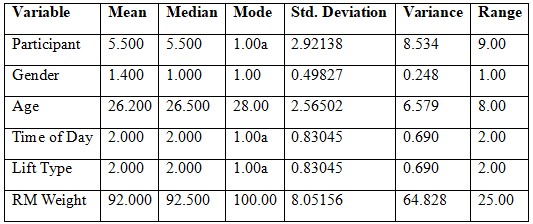 *Note: For variables with multiple modes, the smallest value is shown.
*Note: For variables with multiple modes, the smallest value is shown.
Mean and Median Values: It was also 92 kg the mean 10 RM weight lifted for FLX and 74.5 kg for NO INV. 5 kg showing the measure near the middle of the observed values.
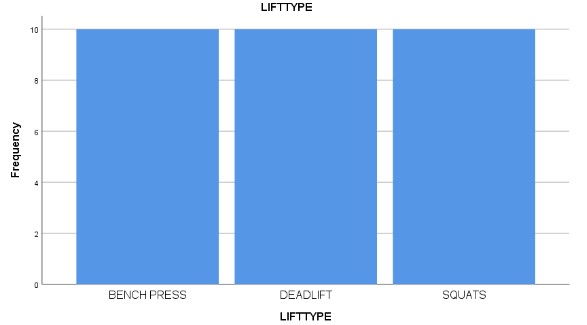
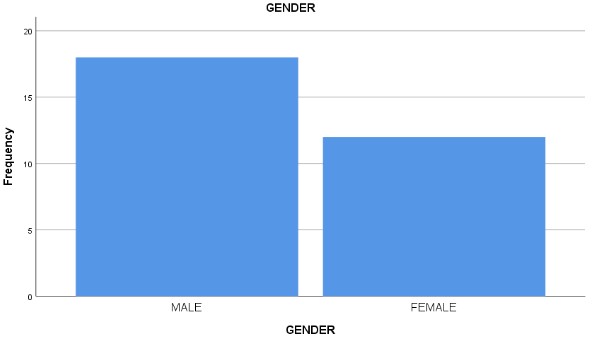
Mode: For the 10RM weight the mode was 100 kg, given this weight is the one that the participants most likely lifted.
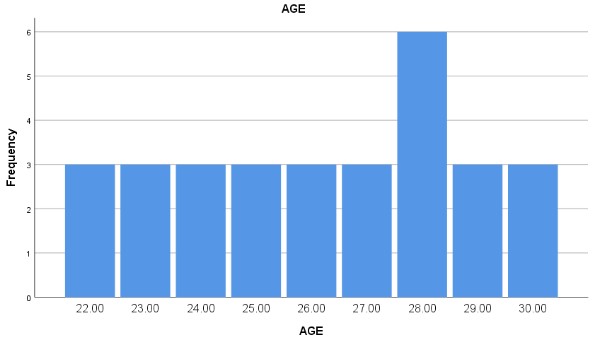
Standard Deviation and Variance: Similarly to the last case, ANOVA shows that the standard deviation of the outcome is 8. 05 kg shows that the weights lifted have moderate variation with a variance equal to 64. 828, which shows the variation in lifting capacity of all participants was very different.
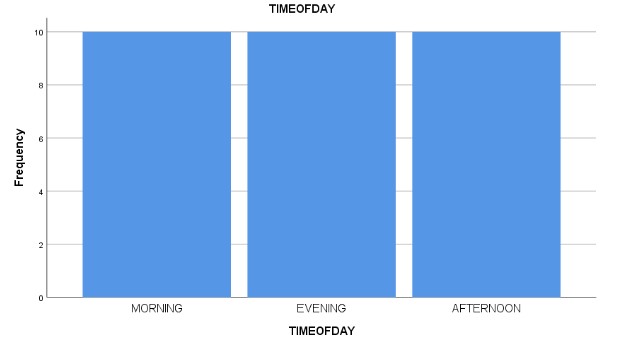
Range: The average weight lifted is 25 kg with the minimum being 80 kg and the maximum being 105 kg.
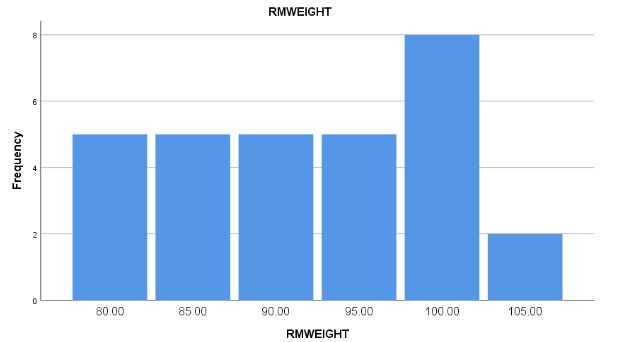
Frequency Distribution of 10RM Weights
The 10RM weights were distributed as follows:


Most of the lifts were in the 80-100 kg category with the 100 kg category being the most dominant with 26. 7%. The fact that there is a smaller portion of lifters going beyond 100 kilograms (6.7% lifting 105 kg) suggests a peak strength threshold around this value for many participants.
Analysis of Variance (ANOVA) for Time of Day
The ANOVA results show that the time of day significantly influenced resistance training performance:

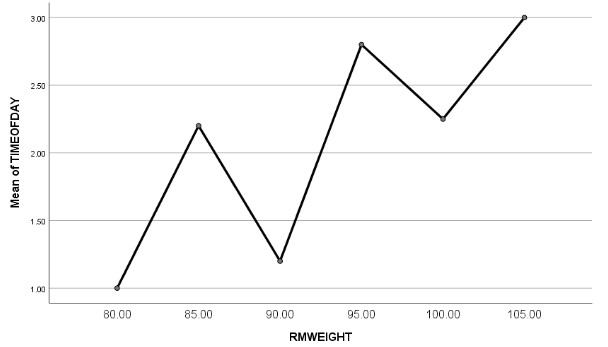
The ANOVA results show that the time of day significantly influenced resistance training performance:
- Between Groups: The sum of squares (14. 1) and mean square (2. 82) show large variance in performance over different times of the day hence giving an F-statistic of 11. 471 and this value is significant on the level of p <. 001.
- Within Groups: The within groups sum of squares (5. 9) demonstrates that the variation within each time group is less than the between groups.
- When the results and/or the delivery of a project is highly dependent upon a particular time of day then time of day must be incorporated in the decision of the composition of the team working on the project and the schedule of each member of the team.
- These highly significant ANOVA findings point to the fact that the time of the day affects resistance training performance. It was observed that the performance level of the participants was different when training was conducted either in the morning, afternoon, or evening. These results support the studies on chronobiology, wherein it has been stated that there is a relation between the performance of physical tasks with the biological rhythms per day, temperature, hormonal output, and ones perceived energy.
Additional Considerations
The study also factored the warm-up exercises and nutritional shifts that are believed to affect training outcomes. Before each training session all the participants went through the general warm-up routine which is consistent with the recommendations Consequently, this study has demonstrated the need to practice resistance training at different times of the day. The effect of time on performance means that businesses should consider the choices of people and biological clocks during training. These findings could benefit athletes, coaches, and fitness enthusiasts, especially in devising a particular training regimen best suited for such key performance periods, thus improving overall training efficiency. Future studies should seek to investigate other accounts of the physiological and subjective factors such as hormonal changes and perceived energy and motivation underlying time-of-day effects. The reduction of the factor of time of day so far as resistance training is concerned for having a focused and effective discussion.
Discussion
It is therefore possible to conclude from the findings of this study that resistance training performance as determined by the 10-repetition maximum weights lifted on bench press, deadlift, and squats, is influenced by the time of the day. There was also statistical evidence of differences in performance across the morning, afternoon, and evening sessions F (2, 158) = 11. 471, p < . 001; thus, indicating that there might be a relation between performance and circadian rhythms. All of these findings support prior studies writing about time-of-day impact on performance and, therefore, the necessity to consider these factors when designing training schedules.
The Effects of Circadian Rhythms on Tweens Physical Activity
There are daily physiological oscillations that control temperature regulation, hormone secretion, and energy substrate utilization that impact physical performance (Nobari et al., 2023). Performance is found to occur in late afternoons or early evenings when the core body temperature is at a high level and musculoskeletal power, enzyme activity and nerve conductivity are at their best as postulated by Chtourou and Souissi, 2012. This may explain why it has been noted that the performance in resistance training in this study was influenced by the time of day. These higher performances were observed namely in the afternoon as well as evening sessions; while there could be many reasons, these may have included higher actual core temperature of the body, increased testosterone levels, and greater perceived energy and well-being during these times.
Hormonal Influence on Performance
Testosterone and cortisol are examples of hormones that show circadian rhythm and impact on strength as well as muscle hypertrophy (Kraemer et al., 2001). Muscle strength and growth hormones are said to be high, especially in the morning; however, this does not necessarily have to correspond with high levels of performance because, at the same time cortisol a negative muscle builder is also high in the morning (Hayes et al., 2010). On the other hand, the cortisol levels are known to decrease during the day, and this may explain the increase in performance, during the afternoon and evening, as the anabolic environment is slightly more conducive (Bird & Tarpenning, 2004).
Psychological and Perceptual Factors
Motivational state, perceived effort, and mood affect exercise performance, and they are daily-varying characteristics (Chtourou et al., 2012). The level of Perceived exertion is always lower in the afternoon and evening thus providing a higher level of work accomplishment in these periods as proposed by Reilly and Garrett (1998). Further, it may be pleasant at night giving athletes a better feel during afternoon and evening performances as compared to morning sessions.
Implications for Training Programs
The major implications of this study implicating that, the athletes and coaches should consider time when organizing their resistance training. In the case where training is being conducted in the afternoon or the evening, there will likely be improved performance outcomes when undertaking activities that are strength-based. Nevertheless, the daily fluctuations of patients cognitive performance depending on the chronotype must be considered as well (Vitale & Weydahl, 2017). There is possibly an advantage of training schedules that are individualized for peak and trough periods to give a competitive edge and improve the training outcome.
Further, it could be suggested that the intensity of adaptations to the conducted training could vary depending on the time of the day because of the various hormonal changes.
Sedliak et al. (2008) in his study found that the lifts may benefit from increased strength when the training is exercised at a time that best suits the performer. As a result, adaptation of the time-of-day-specific intervention strategies into the periodized training schedules may serve to enhance training effects.
The influence of warmth-up regimens as well as eating timing which are components of enhancing performance were also factored out in this study (Fradkin et al., 2010; Rothschild et al., 2020). That is, consistent warm-up routines assist in raising the core temperature and the elasticity of muscles and may further prevent fluctuations in efforts during the different times of the day. The timing of the meals should be correct like pre-workout meals and intra-workout meals which must contain carbohydrates and proteins to keep an individual going through the training session properly regardless of the time the session is taken in the day.
Sport-relevant and overall health and physical fitness lessons can also be derived from this study. For athletes, training sessions should therefore be planned in the part of the day when the strength and power output of the athlete is at its best. This becomes important, especially in competitive situations where timing more often than not has the potential to make a big difference.
Practical Applications and Future Research
More investigations need to be conducted in a bid to unravel the causal factors that contribute to the difference in performance resistive training across various times of the day. Research proposals could look at the effect of circadian rhythms on factors like Muscle Fibre Recruitment, Neuromuscular Efficiency, and Metabolic responses. Furthermore, studies that identify how chronotypes affect the ability to adapt to training during certain times can lead to more personalized training advice.
Further, to reveal new findings, it is possible to examine the relationship between sleep, recovery, and the time dedicated to training. An effective recovery process is crucial for enhancing performance and training interruption of circadian rhythms, for example, due to shift working, irregular sleep, or even jet lag, could affect training results negatively (Facer-Childs & Brandstaetter, 2015). Knowledge of how such factors relate to the training time shall be vital in the formulation of perfect performance-enhancing measures.
Conclusion
In conclusion, this study highlights the significant impact of time of day on resistance training performance, emphasizing the need to consider circadian rhythms in training schedules. By aligning training sessions with the body's natural performance peaks, athletes can enhance their strength and power output, leading to improved overall performance. These findings provide a foundation for further research into the timing of training and its effects on physiological and psychological variables, ultimately contributing to the field of sports science and performance optimization.
Are you struggling to keep up with the demands of your academic journey? Don't worry, we've got your back!
Exam Question Bank is your trusted partner in achieving academic excellence for all kind of technical and non-technical subjects. Our comprehensive range of academic services is designed to cater to students at every level. Whether you're a high school student, a college undergraduate, or pursuing advanced studies, we have the expertise and resources to support you.
To connect with expert and ask your query click here Exam Question Bank

